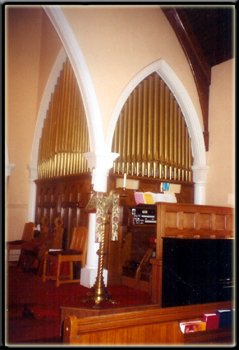St. Mark’s Schudi Organ, Opus 41
Dedicated June 6, 1993
1906 Pilcher organ before the remodel
From an initial contact of April 5, 1987, the Schudi Organ Company was invited to inspect and evaluate the condition of an existing Henry Pilcher organ. This instrument had served the congregation of St. Mark's Episcopal Church since 1906. Changes to the stoplist had been made over the years and the organ was adequate, but extremely limited by its seven stops.
A determination was made to construct a new instrument for St. Mark's. Replacement of the Pilcher organ would include incorporation of much of the existing pipework while utilizing all new mechanical components. The instrument would be located in the same areas as the original instrument and placed behind a new two-sided case front. To this end, the first proposal for such an instrument was submitted by the Schudi Organ Company on April 30, 1987. Several years passed while the deliberation process continued. A contract for a new instrument was negotiated on December 10, 1991.
There were prepared for stops in this initial agreement. Additional funding was secured before the organ was completed, allowing more new stops to be installed than had previously been anticipated. Final installation began in May of 1993 and the completed organ was dedicated on Sunday evening, June 6, 1993.
St. Mark's current organ, dedicated in 1993
The Schudi organ, Opus 41, is a two-manual and pedal instrument comprised of 15 independent registers, 17 stops, and 19 ranks of pipes. The instrument employs mechanical-key (tracker) action and electric stop action. Highly efficient and space-saving slider-pallet windchests are used to deliver air to the various stops of the organ. The wind system of the instrument utilizes a high-speed blower located in the basement of the church that feeds one static reservoir under the floor of the organ area. This reservoir provides constant air pressure to the Pedal windchest (located at the rear of the instrument) and to a secondary reservoir which feeds both manual divisions. Wind stabilizers are utilized on each windchest.
A solid-state combination action controls the drawknob solenoids which activate individual slider-motors for the stop action of the instrument. A highly regulated power supply provides the direct current needed for these functions.
The manual keyboards of the instrument are covered with bone for the naturals and solid ebony for the accidentals. The "window box" design of the console area affords direct coupling with the instrument and immediate connection to the mechanical key action. Solid Honduras mahogany was chosen for the stopjambs providing a rich contrast to the oak casework. The pedalboard keys have opposing rosewood sharps and birdseye-maple naturals.
The present-day organ case is a highly visible structure that fits into the existing worship area with a structural and architectural integrity that virtually defies a date stamp for its artistic appearance.
The casework of the organ was a collaborative effort between Schudi Organ Company and Lamb's Woodworking Shop (formerly of Durango), David Lamb, owner. The design was executed by James A. Stillson of the Schudi firm and the construction was accomplished by Lamb and his associates. Solid, quarter-sawn, white oak was used throughout for this magnificent enhancement to St. Mark's historic sanctuary. Since the church was being renovated at the same time as the organ construction, the choice of stain and finish for the case was left to Lamb. The final dramatic result of this harmonious working arrangement attests to the high standards imposed for the organ's construction by both Lamb and the Schudi firm.
Organ Specifications
Great Division
8' Open Diapason
8' Chimney Flute*
4' Octave
2-2/3' Cornet II
2' Fifteenth
1-1/3' Mixture IV
Cymbelstern
Swell to Great
Swell Division
8' Stopped Diapason*
8' Salicional*
4' Principal*
4' Spire Flute*
2' Piccolo*
8' Oboe
Tremolo
Pedal Division
16' Bourdon*
8' Open Diapason
8' Bourdon
4' Octave
16' Bassoon
Great to Pedal
Swell to Pedal
The asterisk (*) denotes stop from former instrument.
Thanks to
Construction Suppliers:
Solid State Logic, Ltd. (England); Harris Precision Products (Whittier, CA); Aug. Laukhuff (Germany); Carl Ciesecke and Sohn (Germany); Kimber-Allen, Ltd. (England); Jacques Stinkens (Holland); Organ Supply Industries (Erie, PA).
Individuals:
(Contributed their time and artistic talents to the construction, installation, design, and tonal finishing)
James A. Stillson, Jim Lane, Charles V. Leonard, Nanette K. Gordon, David Lamb, Mark W. Lively, Paul Fulcher, Robert L. Sipe and Marvin G. Judy.


